Abstract
The proliferation of nonlinear loads and integration of renewable energy sources require attention for accurate harmonic estimation along with estimation of fundamental amplitude, phase, and frequency for protection, improving power quality, and managing power effectively in a smart distribution grid. There are currently different Windowed Interpolated Fast Fourier Transform (WIFFT) algorithms for harmonic voltage estimation, but estimation of current harmonics using WIFFT is not explored sufficiently. The existing WIFFT algorithms, when used for current harmonic estimation result in low accuracy due to spectral leakage and picket fence effect. On the other hand, Interpolated Discrete Fourier Transform (DFT) is used for synchrophasor quality metrics, but it is effective only when there are no harmonics and the fundamental frequency is constant. This paper proposes a unified solution, comprising of peak location index search (PLIS)-based Dual-Spectrum Line Interpolated Fast Fourier Transform (DSLIFFT) algorithm with 4-Term Minimal Sidelobe Cosine Window (4MSCW) for estimating both low-amplitude voltage or current harmonics and synchrophasor under variable frequency conditions for high-penetration renewable energy utility grids. The effectiveness of the proposed algorithm is validated by simulation studies and real-time experimentation using the National Instruments reconfigurable embedded system under nonlinear loading conditions.
1. Introduction
Accurate estimation of current and voltage harmonics, as well as real-time measurement of voltage space vectors, i.e., synchrophasors, are essential for power electronic based nonlinear loads and the integration of renewables in the modern distribution network. The methodology must be simple and allow fast computation for harmonics and synchrophasor, simultaneously, with retrofit computation capabilities. This paper contributes to advancing such a technology, in designing a suitable compensation and protection devices for the modern distribution network. Moreover, for the accuracy of the estimation method, as well as the requirements of international standards [1,2,3], it is important to have a fast, accurate, and easy-to-design compensation devices. The total harmonic distortion limits must be maintained at less than 5% as per the Institute of Electrical and Electronics Engineers (IEEE) standard 519-2014 [4].
Numerous signal processing methods have been adopted for the estimation of power system harmonics [5,6]. These methods are classified as non-parametric and parametric methods as reviewed in [5]. Parametric methods such as Estimation of Signal Parameters via Rotational Invariance Technique (ESPRIT), Multiple Signal Classification (MUSIC), Kalman Filter (KF), and Prony method require the prior information of the estimation signal for modeling; otherwise, it leads to erroneous results [5,6]. The computation time requirements of these methods are comparatively high. Moreover, they require appropriate load modeling [5,6]. To overcome these issues, non-parametric methods such as Fast Fourier Transform (FFT), Chirp Z-Transform (CZT), Wavelet Transform (WT), and Hilbert Hung Transform (HHT) are also evolved for harmonic estimation [5,6]. Given computational efficiency and simplicity, FFT is considered to be a highly suitable estimation method among all other parametric methods [6]. However, the FFT method has a limitation of spectral leakage and picket fence effect because of non-synchronous sampling due to variation in fundamental frequency [7]. To minimize the spectral leakage, window functions are adopted, and interpolation algorithms have been proposed to minimize the picket fence effect [7,8,9,10,11,12,13,14,15,16,17,18,19,20,21,22,23]. Thus, Windowed Interpolated FFT (WIFFT) algorithms have come into existence. However, due to fluctuating nature of harmonics caused by modern nonlinear loads and variations in fundamental frequency, there is no standard window and its associated interpolation algorithm for estimation of power system harmonics.
The accuracy of the harmonic estimation depends on the type of window and its corresponding interpolation algorithm. The window is selected based upon the narrowed main lobe, smaller sidelobe width, and rapid sidelobe roll of rate. The precise estimation of amplitude, frequency, and phase of the fundamental, as well as harmonics, depends on the window properties. Moreover, the minimization of spectral leakage is dependent on window length, window coefficients, and sampling frequency [6]. In [8,9] detailed discussion of windows and its properties are reported, especially for harmonic estimation. From the past two decades, various WIFFT algorithms using Hanning Window, Hamming Window, Blackman Window, Advanced Cosine Windows, Hanning Self-Convolution Window, Cosine Self-Convolution Window, Triangular Self-Convolution Window, Adaptive Kaiser Self-Convolution Window, Mutual Multiplication Window and Nuttal-Kaiser Window for harmonic analysis are reported in the literature [7,10,11,12,13,14,15,16,17,18,19,20,21,22]. Recently the Nuttall Window with triple-spectrum line interpolated FFT for analysis of harmonics was reported in [23]. However, a Dual-Spectrum Line Interpolated FFT (DSLIFFT) algorithm has been widely used for most of the above stated windows. Moreover, the DSLIFFT with the above windows is focused on voltage harmonics estimation. However, estimation of current harmonics is also important to explore as per the revised International Electro-technical Commission (IEC) 61000-4-30 standard [2] due to the exponential diffusion of nonlinear loads on the distribution network. Regarding current harmonics, the fundamental amplitude is lower. In this case, the DSLIFFT algorithm accuracy is low because of the identical harmonic spectral lines on different frequency bins. Moreover, the computation complexity is also another factor, which demands the enhancement of existing DSLIFFT for current harmonic estimation. Therefore, computational burden aspects can be quite interesting in big data analytics applications, where large amounts of data to uncover hidden patterns, correlations, and other insights [24]. However, the accurate estimation of the current harmonics is not explored sufficiently.
Further FFT is also used for synchrophasor estimation [25]. In [26], application of space-vector interpolated Discrete Fourier Transform (DFT) method is presented for synchrophasor estimation. However, estimation under harmonic conditions is not reported. Moreover, WIFFT algorithm application for harmonic and synchrophasor estimation simultaneously under unstable fundamental frequency is not explored enough. As per the IEEE Standard C37.118.1a-2014 Phasor Measuring Units (PMUs) are classified as P-class and M-class for fast and accurate estimation of phasors under different abnormal conditions [27]. Recently reduced leakage synchrophasor estimation using Hilbert transform plus the interpolated DFT has been reported in [28]. However, the research is still in progress for developing the unified algorithm for P- and M-class PMUs regarding accuracy and simplicity.
Therefore, during the estimation of current harmonics and synchrophasor, the following issues need to be addressed. WIFFT is a simple and easy-to-implement method for harmonic voltage estimation; however, selection of the suitable window function and improvement of existing DSLIFFT for estimating the current harmonics accurately are essential. On the other hand, the improvement of synchrophasor estimation accuracy under variable frequency and harmonic conditions also need to be addressed. To address the above issues, in this article, a Peak Location Index Search (PLIS)-based DSLIFFT algorithm using 4-Term Minimal Sidelobe Cosine Window (4MSCW) is proposed as a generic approach to harmonics estimation (voltages or current) and synchrophasor at the same time under variable frequency operation. Because of the reasonable main lobe, lower sidelobe level and fast sidelobe roll of the rate the 4MSCW proposed in [14] has been adopted for PLIS-based DSLIFFT estimation process.
The Real-Time (RT) implementation of the proposed PLIS-based DSLIFFT algorithm using 4MSCW algorithm and its current harmonic and synchrophasor estimation accuracy with real-world nonlinear loads has been presented in this article.
The major contributions in this paper are as follows
- A PLIS-based DSLIFFT algorithm is presented for simplifying the estimation process and improving the estimation accuracy of low-amplitude voltage or current harmonic signal parameters as well as synchrophasors at a time with a 4MSCW.
- The application of 4MSCW for current harmonic and synchrophasor estimation at a time has been explored.
- The proposed algorithm is implemented and tested in RT with real-world nonlinear loads.
2. Materials and Methods
The 4MSCW functions and its corresponding PLIS-based DSLIFFT algorithm proposed in this article for harmonic and synchrophasor estimation are summarized in the following sections.
2.1. 4MSCW Function Overview
Numerous window functions are reported in the literature for harmonic spectral estimation, but there is a compromise in accuracy because of the window properties, such as main lobe, sidelobe widths, and sidelobe roll-off rates [8,9]. However, Cosine Windows (CWs) such as Hanning, Hamming, and Blackman are the most common window functions adopted in harmonic spectral analysis. Moreover, various CWs are reported in the literature for harmonic estimation [7,8,9,10,11,12,13,14,15,16,18,19,21,22,23]. Apart from another family of windows, CWs are well considered for harmonic estimation.
The basic discrete Cosαx window function is expressed as follows:
By changing the “α” value, different forms of CWs are developed. Here α takes integer values, and N is fixed to 2k, where k is a natural number. Based upon the window function given in Equation (1) various advanced CWs are derived for harmonic estimation [7,8,9,10,11,12,13,14,15,16,18,19,21,22,23]. Given the main lobe, sidelobe, and sidelobe roll of rate requirements a 4MSCW is adopted for harmonic and synchrophasor estimation, a PLIS-based DSLIFFT algorithm has been developed to improve its accuracy matching with the RT signal analysis. The main objective of this algorithm is to estimate the spectral amplitude and phase of the harmonic current signals accurately. The discrete-time 4MSCW with length N and order H is expressed as:
where n represents the sample index, N represents the total number of samples, h denotes the fundamental and harmonic numbers and ah represents the window coefficients. The CWs are developed based upon the H and ah values to meet the computation requirements of the interpolation technique. The coefficients of ah must comply with the following conditions.
The spectral window corresponding to the 4MSCW derived from Equation (1) by using the Discrete-Time Fourier transform (DTFT) is written as follows
Concerning the 4MSCW properties regarding the main lobe width between zero crossing, it must fulfill the following condition to get the |WMSCW (n)| values as zeros.
The adopted 4MSCW functions of type-1 and type-2 coefficients and properties adopted from [14] are tabulated in Table 1.

Table 1.
4MSCW Coefficients and Properties.
2.2. Mathematical Formulation of PLIS-Based DSLIFFT
The mathematical formulation of the harmonic signal is represented as:
where the amplitude, frequency, and phase are denoted as Ah, fh and φh, respectively. The sampling time of the signal is represented as Ts. Due to the unstable nature of the fundamental frequency, the sampling is non-synchronous, which leads to spectral leakage. To suppress the spectral leakage effect, the sampled signal is weighted by the window function. The FFT of the windowed sample signal under non-synchronous sampling is represented as:
where k = 0, 1 … (N – 1), WMSCW indicates the FFT of the 4MSCW function, kh denotes the division factor of signal frequency and the frequency resolution, which is expressed as:
where lh is an integer value and ξh (0 ≤ ξh ≤ 1) is the fractional part. The negative frequency part is ignored in Equation (8). The sampling frequency used for computation is represented as fs. The lh and ξh are computed by PLIS-based DSLIFFT algorithm as described in the next section.
2.3. PLIS-Based DSLIFFT Algorithm
The detailed flowchart of the proposed PLIS-based DSLIFFT algorithm is depicted in Figure 1. The input current harmonic signal is sampled and weighted by the adopted 4MSCW after that the spectrum is computed. To compute the fundamental and harmonic peaks, PLIS method is proposed. In this method, a threshold factor (τ) is defined to ignore the estimation of peak locations of all the frequency bins. By defining the threshold factor, the peak location indexes are identified for the dominant harmonic frequency bins. Initially, the harmonic index is defined as I, and the threshold factor is considered to be 0.1% of the fundamental amplitude. The threshold factor is calculated from the relation between the fundamental and the considerable lowest harmonic amplitude which will contribute to the total harmonic distortion (THD). The importance of the threshold factor is to identify the significant harmonic peak value corresponding to the lower order harmonics. The threshold factor of 0.1% in PLIS method is based on the considerable dominant harmonic peak value concerning its fundamental amplitude. Usually, the least harmonic amplitudes which will impact the signal quality in the current signal will be 0.1% of the fundamental amplitude based on the knowledge of different nonlinear load current harmonic data. Therefore, threshold factor is considered to be 0.1%, to obtain the harmonic peak amplitudes. Afterward, DSLIFFT correction is applied to estimate the amplitude, phase, and frequency of the fundamental as well as all other harmonic orders. This procedure effectively decreases the computation process. However, the peak search process in the conventional DSLIFFT algorithm reported in the literature [11,12,13,14,15,16,17,18,20,21,22,23] will check for the entire frequency bin peak locations, which in turn increases the computation burden.
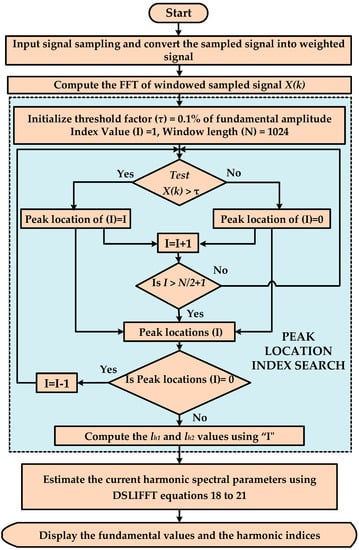
Figure 1.
PLIS-based DSLIFFT algorithm.
The main objective of the PLIS method is to identify the fundamental as well as adjacent harmonic spectral lines accurately.
2.4. Overview of DSLIFFT
After obtaining the locations of the spectral lines, an interpolation method is applied to estimate the amplitude, phase, and frequency of the harmonic signal. The conventional DSLIFFT algorithm presented in the literature [11,12,13,14,15,16,17,18,19,20,21,22] is improved by using the PLIS method. The spectral line location of the hth harmonic component can be obtained from the PLIS method. The ξh can be estimated from the interpolation method from which amplitude, phase, and frequency of hth harmonic can be accurately computed. The pictorial representation of the PLIS-based DSLIFFT using 4MSCW is illustrated in Figure 2.
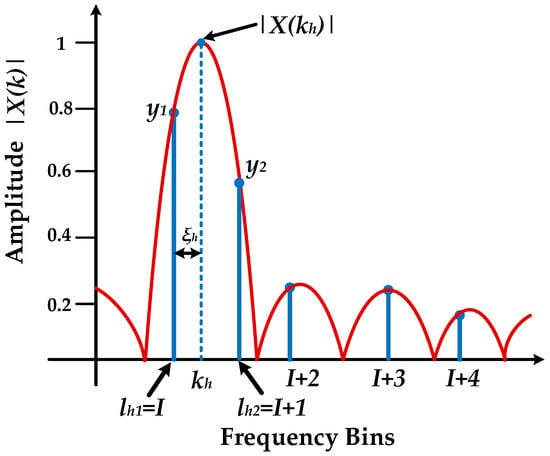
Figure 2.
PLIS-based DSLIFFT algorithm with 4MSCW.
The frequency spectrum expression is written as [11,12,13,14,15,16,17,18,19,20,21,22]:
The two amplitude spectral lines represents the hth harmonic is considered to be lh1 and lh2 (where lh1 = I lh2 = I + 1, lh1 < kh < lh2). The peak locations of the harmonic amplitudes are obtained from PLIS method.
Let y1 = |X(I)| and y2 = |X (I + 1)|, then y1 and y2 are written as follows:
The least-square curve fitting is used to find the spectral amplitudes. The resultant expression of an independent variable α is expressed as
The y1 and y2 are expressed as
To compute the harmonic parameters, a symmetrical coefficient β which is a function of α is considered, where the β expression regarding α can be written as
From Equations (13) and (14), can be expressed as
Based on the window order, the α expression concerning β is derived from least-square curve fitting technique. The relation between α and β is derived as follows using the polynomial approximations.
The polynomial coefficients of 4MSCW type-1 and type-2 coefficients are tabulated in Table 2.

Table 2.
4MSCW Polynomial Coefficients.
After calculating the α value, the amplitude, frequency and phase values are calculated based upon the following interpolated formulas
The main enhancement in this interpolation algorithm is a PLIS method, which is used to determine the amplitude of dominant harmonic frequency peak locations, instead of searching the amplitudes of all the frequency bins peak locations. Then interpolation is applied to estimate the amplitude, phase, and frequency of the fundamental as well as harmonic components, where the fundamental component estimation is useful for synchrophasor processing. The proposed algorithm is developed in RT using Laboratory Virtual Instrument Engineering Workbench (LabVIEW) programmed National Instruments (NI) compact Reconfigurable Input/output system (cRIO) system described in [29].
3. Simulation Results
This section demonstrates the simulation results of the proposed PLIS-based DSLIFFT using 4MSCW. Initially, the proposed algorithm simulated in a LabVIEW environment with a programmed harmonic test signal. The amplitudes and the corresponding phases of the programmed harmonic signal for fundamental frequency values of 49.5 Hz and 50.5 Hz are depicted in Table 3. The signal frequencies are considered as 49.5 Hz and 50.5 Hz to justify the estimation accuracy under non-synchronous sampling frequency, the input signal is analyzed by using PLIS-based DSLIFFT with 4MSCW. The proposed PLIS-based DSLIFFT using 4MSCW results are compared with the conventional DSLIFFT algorithm reported in [11,12,13,14,15,16,17,18,19,20,21,22] using 4MSCW. The simulated benchmark signal waveform representation is depicted in Figure 3.

Table 3.
Simulated harmonic test signal information.
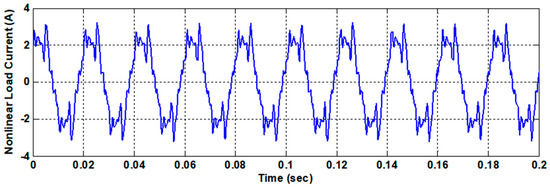
Figure 3.
Benchmark harmonic test signal.
The amplitude estimation of the benchmark harmonic test signal and its error comparison for 4MSCW type-1 and type-2 with fundamental frequency values of 49.5 Hz and 50.5 Hz are tabulated in Table 4, Table 5, Table 6 and Table 7. Correspondingly the fundamental and harmonic frequencies and phase estimation values are depicted in Table 8, Table 9, Table 10, Table 11, Table 12, Table 13, Table 14 and Table 15.

Table 4.
Amplitude estimation comparison using 4MSCW type-1 with DSLIFFT and proposed PLIS-based DSLIFFT, when the fundamental frequency = 49.5 Hz.

Table 5.
Amplitude estimation comparison using 4MSCW type-2 with DSLIFFT and proposed PLIS-based DSLIFFT, when the fundamental frequency = 49.5 Hz.

Table 6.
Amplitude estimation comparison using 4MSCW type-1 with DSLIFFT and proposed PLIS-based DSLIFFT, when the fundamental frequency = 50.5 Hz.

Table 7.
Amplitude estimation comparison using 4MSCW type-2 with DSLIFFT and proposed PLIS-based DSLIFFT, when the fundamental frequency = 50.5 Hz.

Table 8.
Frequency estimation comparison using 4MSCW type-1 with DSLIFFT and proposed PLIS-based DSLIFFT, when the fundamental frequency = 49.5 Hz.

Table 9.
Frequency estimation comparison using 4MSCW type-2 with DSLIFFT and proposed PLIS-based DSLIFFT, when the fundamental frequency = 49.5 Hz.

Table 10.
Frequency estimation comparison using 4MSCW type-1 with DSLIFFT and proposed PLIS-based DSLIFFT, when the fundamental frequency = 50.5 Hz.

Table 11.
Frequency estimation comparison using 4MSCW type-2 with DSLIFFT and proposed PLIS-based DSLIFFT, when the fundamental frequency = 50.5 Hz.

Table 12.
Phase estimation comparison using 4MSCW type-1 with DSLIFFT and proposed PLIS-based DSLIFFT, when the fundamental frequency = 49.5 Hz.

Table 13.
Phase estimation comparison using 4MSCW type-2 with DSLIFFT and proposed PLIS-based DSLIFFT, when the fundamental frequency = 49.5 Hz.

Table 14.
Phase estimation comparison using 4MSCW type-1 with DSLIFFT and proposed PLIS-based DSLIFFT, when the fundamental frequency = 50.5 Hz.

Table 15.
Phase estimation comparison using 4MSCW type-2 with DSLIFFT and proposed PLIS-based DSLIFFT, when the fundamental frequency = 50.5 Hz.
Table 4, Table 5, Table 6, Table 7, Table 8, Table 9, Table 10, Table 11, Table 12, Table 13, Table 14 and Table 15 concern amplitude, frequency, and phase estimation results using 4MSCW of type-1 and type-2-based DSLIFFT algorithm and proposed PLIS-based DSLIFFT algorithm. In view of the simulated results, the PLIS-based DSLIFFT with4MSCW of type-2 has better accuracy than the 4MSCW of type-1. Moreover, it is evident that the accuracy of the 4MSCW of type-2 with proposed PLIS-based DSLIFFT algorithm with respect to the percentage relative errors of the fundamental amplitude, phase, and frequency are in the order of 10−3, 10−9, and 10−2 and it exhibits better results than the 4MSCW of type-2 with conventional DSLIFFT algorithm with different harmonic amplitudes.
The percentage relative error variations of fundamental and harmonic amplitudes, frequencies and phases estimation to the harmonic orders with proposed PLIS-based DSLIFFT and conventional DSLIFFT using 4MSCW type-1 and type-2 at frequency values of 49.5 Hz and 50.5 Hz are depicted in Figure 4, Figure 5, Figure 6, Figure 7, Figure 8 and Figure 9. From the responses of Figure 4, Figure 5, Figure 6, Figure 7, Figure 8 and Figure 9, it is evident that the 4MSCW type-2 with proposed PLIS-based DSLIFFT algorithm exhibits more accurate estimation over the 4MSCW type-1 with the proposed algorithm as well as 4MSCW type-1 and type-2 with conventional DSLIFFT algorithm. Moreover, the fundamental amplitude, frequency, and phase estimation are more accurate in view of its lowest percentage relative error values under different fundamental frequencies.
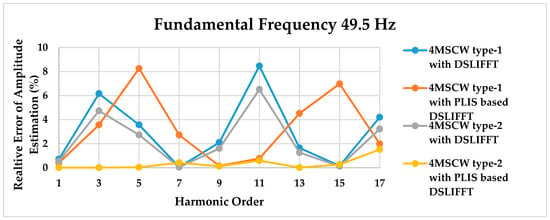
Figure 4.
Percentage relative errors variation of amplitude estimation to the harmonic order with proposed PLIS-based DSLIFFT and conventional DSLIFFT using 4MSCW type-1 and type-2 at the frequency is 49.5 Hz.
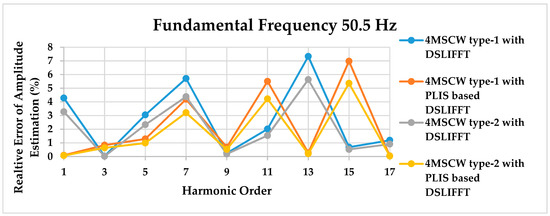
Figure 5.
Percentage relative errors variation of amplitude estimation to the harmonic order with proposed PLIS-based DSLIFFT and conventional DSLIFFT using 4MSCW type-1 and type-2 at the frequency 50.5 Hz.
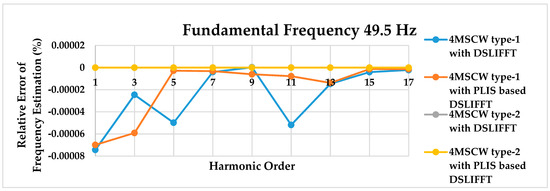
Figure 6.
Percentage relative errors variation of frequency estimation to the harmonic order with proposed PLIS-based DSLIFFT and conventional DSLIFFT using 4MSCW type-1 and type-2 at the frequency 49.5 Hz.
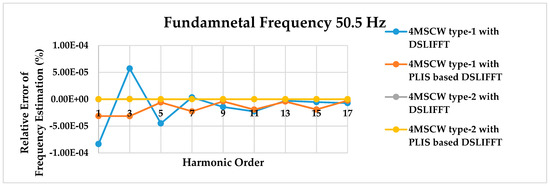
Figure 7.
Percentage relative errors variation of frequency estimation to the harmonic order with proposed PLIS-based DSLIFFT and conventional DSLIFFT using 4MSCW type-1 and type-2 at the frequency 50.5 Hz.
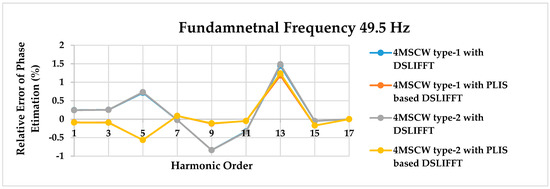
Figure 8.
Percentage relative errors variation of phase estimation to the harmonic order with proposed PLIS-based DSLIFFT and conventional DSLIFFT using 4MSCW type-1 and type-2 at the frequency 49.5 Hz.

Figure 9.
Percentage relative errors variation of phase estimation to the harmonic order with proposed PLIS-based DSLIFFT and conventional DSLIFFT using 4MSCW type-1 and type-2 at the frequency is 50.5 Hz.
The RT validation of the proposed PLIS-based DSLIFFT algorithm on estimating the real-world harmonic signals are presented in the next section.
4. RT Validation
The RT implementation of the proposed PLIS-based DSLIFFT using 4MSCW is discussed in this section. The detailed experimental setup and its drawing are depicted in Figure 10. Precise selection of sampling frequency and window size gives the accurate results in RT. For better accuracy and minimized errors, the sampling frequency is considered to be 3 kHz and the window size is 1024 as per the sampling theorem concepts. Moreover, the sampling frequency satisfies the Nyquist frequency requirement. Based on the sampling frequency and the window length the frequency resolution satisfies the measurement requirements as discussed in [6]. The RT process flowchart in RT estimation is shown in Figure 11.
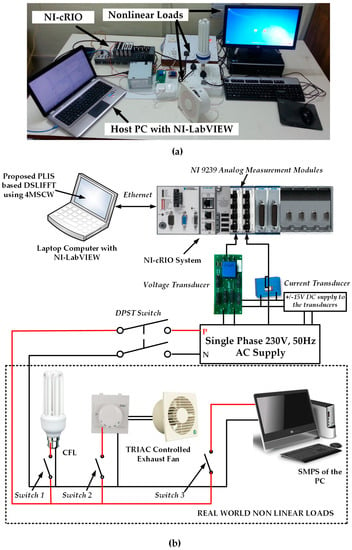
Figure 10.
NI-cRIO-based experimental setup. (a) Lab setup; (b) Setup drawing.
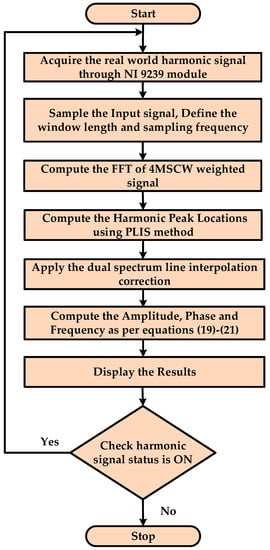
Figure 11.
Flowchart of the proposed PLIS based DSLIFFT Algorithm with 4MSCW in RT estimation.
The common real-world loads such as Compact Fluorescent Lamp (CFL), Triode for Alternating Current (TRIAC) controlled exhaust fan and Switched Mode Power Supply (SMPS) of the Personal Computer (PC) to serve different nonlinear loads are considered for estimation. NI-cRIO-based virtual instrumentation experimental setup is developed for harmonic and synchrophasor estimation. It is one of the potential RT estimation tools for the harmonic signal and synchrophasor as per the international standards [1,2,3]. The cRIO uses Field-Programmable Gate Array (FPGA) architecture for digital signal processing. The proposed PLIS-based DSLIFFT using 4MSCW has been deployed in the LabVIEW configured host computer and interfaced to the NI LabVIEW powered cRIO 9082 which is equipped with Intel Core-i7 dual core with a Central Processing Unit (CPU) frequency of 1.33GHz [29]. It consists of a reconfigurable embedded chassis with integrated intelligent real-time controller and data acquisition modules for signal acquisition. The real-world harmonic loads considered for RT harmonics and synchrophasor analysis are shown in Table 16.
| The procedural steps to implement the PLIS-based DSLIFFT algorithm with 4MSCW in RT | |
| Step 1 | Sampling the real-world harmonic signal, here the harmonic signal is acquired from real-world nonlinear load using NI 9239 analog module [30]. |
| Step 2 | The acquired signal is processed through the FPGA I/Os of NI-cRIO 9082 system [29], then convert the sampled signal into a weighted signal using 4MSCW and compute the weighted signal FFT. |
| Step 3 | The NI-cRIO 9082 system is interfaced to the host computer, where the proposed PLIS-based DSLIFFT algorithm using 4MSCW method is implemented in LabVIEW virtual instrumentation environment. |
| Step 4 | Use the PLIS-based DSLIFFT algorithm using 4MSCW of type-2 to find out the fundamental as well as harmonic spectral amplitudes accurately. |
| Step 5 | Display the results. |

Table 16.
Real-world nonlinear load data.
The nonlinear loads (CFL+SMPS of the PC) current waveform acquired by using NI-cRIO is depicted in Figure 12, where the switch 1 and switch 2 of the nonlinear loads are in ON position and switch 3 of the exhaust fan is in OFF position. The NI-cRIO is a Heterogeneous computing platform, where the signal acquisition is done by using FPGA configured input channels and computation is performed on the RT processor.
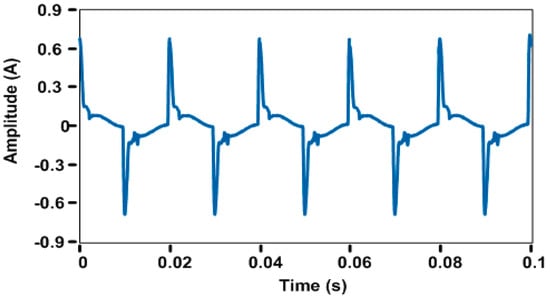
Figure 12.
CFL and Computer with UPS load current waveform.
4.1. Case 1: RT Harmonic Estimation of CFL and SMPS of the PC
The amplitude, phase, and frequency of the fundamental and harmonics estimated by the proposed laboratory RT experimental test bench (NI-cRIO) and the Tektronix Power Quality Analyzer (PQA) model PA4000 [31] are tabulated in Table 17, Table 18 and Table 19. The Tektronix PA4000 is one of the standard instrument used for the voltage or current harmonic estimation. The PQA results and the 4MSCW type-2-based proposed PLIS-based DSLIFFT configured RT estimation system results are relatively identical and the proposed system exhibits better accuracy under the nonlinear loaded condition as per the requirement of international standards [1,2,3].

Table 17.
Case 1: Comparison of proposed PLIS-based DSLIFFT with type-2 4MSCW and Tektronix PQA.

Table 18.
Case 1: Comparison of proposed PLIS-based DSLIFFT with type-2 4MSCW and Tektronix PQA.

Table 19.
Case 1: Comparison of proposed PLIS-based DSLIFFT with type-2 4MSCW and Tektronix PQA.
4.2. Case 2: RT Harmonic Estimation of TRIAC Controlled Exhaust Fan Load
The current drawn by the exhaust fan only when the CFL and SMPS of the PC loads are in OFF condition is shown in Figure 13. The RT system and the PQA estimation results of amplitude, frequency, and phase for exhaust fan case also depicted in Table 20, Table 21 and Table 22. These results also exhibit the identical accuracy of the proposed algorithm in RT estimation of fundamental and harmonic components.

Figure 13.
TRIAC controlled Ventilating Electric Fan load current waveform.

Table 20.
Case 2: Comparison of proposed PLIS-based DSLIFFT with type-2 4MSCW and Tektronix PQA.

Table 21.
Case 2: Comparison of proposed PLIS-based DSLIFFT with type-2 4MSCW and Tektronix PQA.

Table 22.
Case 2: Comparison of proposed PLIS-based DSLIFFT with type-2 4MSCW and Tektronix PQA.
It is clear that the proposed PLIS-based DSLIFFT with 4MSCW of type-2 has improved characteristics when compared to the conventional DSLWIFFT for nonlinear load current harmonic estimation. The proposed PLIS-based DSLIFFT with 4MSCW of type-2 has improved accuracy and better online response in compliance with PQA measured data as per IEC 61000-4-30 [2], which recommends the measurement of current harmonics. Therefore, this paper addresses the issues of current harmonic estimation simultaneously with synchrophasors. The above loads are the most common nonlinear loads using in the residential, commercial, and industrial applications. There is a real need to compute these harmonics effectively for mitigation purpose. Moreover, the fundamental quantities estimation such as fundamental amplitude, phase, and frequency is used for synchrophasor applications. It is confirmed by both the simulation and RT results that proposed PLIS-based DSLIFFT with type-2 4MSCW has better accuracy. Furthermore, the accuracy of the fundamental quantities estimation under harmonic distortion condition is high, which is a benefit for the synchrophasor estimation in distorted conditions.
5. Conclusions
This paper proposed a PLIS-based DSLIFFT with 4MSCW for estimation of power system voltages or current harmonics and synchrophasor metrics with advanced efficiency and fast computation. It has better accuracy and precision under non-synchronous sampling, low amplitude, and fractional harmonic frequency when compared to previous solutions. Simulation and experimental results corroborate the effectiveness, using the techniques described in this paper for harmonic and synchrophasor estimation simultaneously under variable frequency conditions. Improved performance indices were examined with experimental results by considering real-world harmonic signals. The simulation and experimental results satisfy requirements of international standards such as IEC 61000-4-7, 4-30, and IEEE 1159-2009. Therefore, our proposed PLIS-based DSLIFFT with 4MSCW can estimate voltage or current harmonics, as well as compute voltage space-vector synchrophasor, even under distorted conditions and variable grid frequencies in real-time, ready to retrofit any power system or smart-grid installation.
Author Contributions
V.S.R.V.O. developed the idea, designed, and performed the experiments. V.S.R.V.O, V.S.S.S.S.D., and M.G.S. contributed to the overall concept development, methodology; V.S.R.V.O., H.K.M.P, and M.G.S. contributed to data analysis; V.S.R.V.O and H.K.M.P contributed to writing of the paper, V.S.S.S.S.D. performed the supervision, V.S.S.S.S.D. and M.G.S. contributed to review, professional advice, and editing the manuscript; all authors have read and approved the final manuscript.
Funding
This research received no external funding.
Acknowledgments
The authors gratefully acknowledge the Department of Electrical Engineering, National Institute of Technology Warangal, INDIA for providing necessary facilities and the Advanced Control of Energy Power Systems (ACEPS) research group of Electrical Engineering Department at Colorado School of Mines, USA for their support. H.K.M.P also would like to thank the São Paulo Research Foundation (FAPESP) under Grant 2016/08645-9 and Grant 2017/22629-9.
Conflicts of Interest
The authors declare no conflict of interest.
References
- IEC. IEC Standard 61000-4-7: General Guide on Harmonics and Interharmonics Measurements and Measuring Instruments for Power Supply Networks and Attached Devices Used for the Measurements; IEC: Geneva, Switzerland, 2009. [Google Scholar]
- IEC. IEC Standard 61000-4-30: Power Quality Measurement Methods; IEC: Geneva, Switzerland, 2015. [Google Scholar]
- IEEE. IEEE Standard 1159-2009: IEEE Recommended Practice for Monitoring Electric Power Quality; IEEE: New York, NY, USA, 2009. [Google Scholar]
- IEEE. IEEE Standard 519-2014 (Revision of IEEE Std 519-1992): IEEE Recommended Practice and Requirements for Harmonic Control in Electric Power Systems; IEEE: New York, NY, USA, 2014. [Google Scholar]
- Jain, S.K.; Singh, S.N. Harmonics estimation in emerging power system: Key issues and challenges. Electr. Power Syst. Res. 2011, 81, 1754–1766. [Google Scholar] [CrossRef]
- Chen, C.I.; Chen, Y.C. Comparative study of harmonic and interharmonic estimation methods for stationary and time-varying signals. IEEE Trans. Ind. Electr. 2014, 61, 397–404. [Google Scholar] [CrossRef]
- Zhang, F.; Geng, Z.; Yuan, W. The algorithm of interpolating windowed FFT for harmonic analysis of electric power system. IEEE Trans. Power Deliv. 2001, 16, 160–164. [Google Scholar] [CrossRef]
- Prabhu, K.M.M. Window Functions and Their Applications in Signal Processing, 1st ed.; CRC Press: Boca Raton, FL, USA, 2013; ISBN 9781466515840. [Google Scholar]
- Harris, F.J. On the use of windows for harmonic analysis with the discrete Fourier transform. Proc. IEEE 1978, 51–83. [Google Scholar] [CrossRef]
- Chang, G.W.; Chen, C.I.; Liu, Y.J.; Wu, M.C. Measuring power system harmonics and interharmonics by an improved fast Fourier transform-based algorithm. IET Gener. Transm. Distrib. 2008, 2, 193–201. [Google Scholar] [CrossRef]
- Chen, K.F.; Li, Y.F. Combining the Hanning windowed interpolated FFT in both directions. Comput. Phys. Commun. 2008, 178, 924–928. [Google Scholar] [CrossRef]
- Wen, H.; Teng, Z.; Guo, S.; Wang, J.; Yang, B.; Wang, Y.; Chen, T. Hanning self-convolution window and its application to harmonic analysis. Sci. China Ser. E Technol. Sci. 2009, 52, 467–476. [Google Scholar] [CrossRef]
- Zeng, B.; Teng, Z. Parameter estimation of power system signals based on cosine self-convolution window with desirable side-lobe behaviors. IEEE Trans. Power Deliv. 2011, 26, 250–257. [Google Scholar] [CrossRef]
- Wen, H.; Teng, Z.; Wang, Y.; Zeng, B.; Hu, X. Simple interpolated FFT algorithm based on minimize sidelobe windows for power-harmonic analysis. IEEE Trans. Power Electron. 2011, 26, 2570–2579. [Google Scholar] [CrossRef]
- Zeng, B.; Zhou, Y.; Teng, Z.; Li, G. A novel approach for harmonic parameters estimation under nonstationary situations. Int. J. Electr. Power Energy Syst. 2013, 44, 930–937. [Google Scholar] [CrossRef]
- Varaprasad, O.V.S.R.; Sarma, D.V.S.S.S.; Panda, R.K. Advanced windowed interpolated FFT algorithms for harmonic analysis of electrical power system. In Proceedings of the National Power System Conference (NPSC), IIT, Guwahati, India, 18–20 December 2014; IEEE: Guwahati, India, 2014; pp. 1–6. [Google Scholar] [CrossRef]
- Rai, P.; Varaprasad, O.V.S.R.; Sarma, D.V.S.S.S. An overview of power harmonic analysis based on Triangular Self Convolution window. In Proceedings of the National Power System Conference (NPSC), IIT, Bhubaneswar, India, 19–21 December 2016; IEEE: Bhubaneswar, India, 2016; pp. 1–5. [Google Scholar] [CrossRef]
- Jin, T.; Chen, Y.; Flesch, R.C. A novel power harmonic analysis method based on Nuttall-Kaiser combination window double spectrum interpolated FFT algorithm. J. Electr. Eng. 2017, 68, 435–443. [Google Scholar] [CrossRef]
- Chintakindi, S.R.; Varaprasad, O.V.S.R.; Sarma, D.V.S.S.S. Improved Hanning window based interpolated FFT for power harmonic analysis. In Proceedings of the TENCON 2015–2015 IEEE Region 10 Conference, Holiday Inn Sands Cotai Central, Macao, China, 1–4 November 2015; IEEE: Macao, China, 2015; pp. 1–5. [Google Scholar] [CrossRef]
- Yao, W.; Teng, Z.; Tang, Q.; Gao, Y. Measurement of power system harmonic based on adaptive Kaiser self-convolution window. IET Gen. Tran. Distrib. 2016, 10, 390–398. [Google Scholar] [CrossRef]
- Tianyuan, T.A.; Wenjuan, C.H.; Kaipei, L.; Xiong, N.; Zhang, J.; Junhua, W.A. Harmonic analysis based on time domain mutual-multiplication window. J. Mod. Power Syst. Clean Energy 2016, 4, 47–53. [Google Scholar] [CrossRef]
- Wen, H.; Dai, H.; Teng, Z.; Yang, Y.; Li, F. Performance comparison of windowed interpolation FFT and quasisynchronous sampling algorithm for frequency estimation. Math. Probl. Eng. 2014, 1–7. [Google Scholar] [CrossRef]
- Zhu, Y.; Wang, Y.; Lin, T.; Feng, C.; Chen, J.; Gao, Y. Harmonic Analysis of Power System Based on Nuttall self-convolution Window Triple-spectral-line Interpolation FFT. In Proceedings of the 2nd International Conference on Control, Automation and Artificial Intelligence (CAAI 2017), Advances in Intelligent Systems Research, Sanya, China, 25–26 June 2017; Atlantis Press: Paris, France, 2017; Volume 134, pp. 438–441. [Google Scholar] [CrossRef]
- Watson, H.J. Tutorial: Big Data Analytics: Concepts, Technologies, and Applications. Commun. Assoc. Inf. Syst. 2014, 34, 1248–1268. [Google Scholar] [CrossRef]
- Ferrero, R.; Pegoraro, P.A.; Toscani, S. Employment of Interpolated DFT-based PMU Algorithms in Three-Phase Systems. In Proceedings of the 2017 IEEE International Workshop on Applied Measurements for Power Systems (AMPS) Sensor City, Liverpool, UK, 20–22 September 2017; pp. 1–5. [Google Scholar] [CrossRef]
- Rodrigues, R.N.; Cavalcante, L.H.; Zatta, J.K.; Schlichting, L.C.M. A Phasor Measurement Unit based on discrete fourier transform using digital signal processor. In Proceedings of the 12th IEEE International Conference on Industry Applications (INDUSCON) Federal University of Technology–Paraná (UTFPR), Curitiba, Brazil, 20–23 November 2016; pp. 1–6. [Google Scholar] [CrossRef]
- IEEE. IEEE Std C37.118.1a-2014:IEEE Standard for Synchrophasor Measurements for Power Systems-Amendment 1: Modification of Selected Performance Requirements, IEEE Std C37.118.1a-2014 (Amendment to IEEE Std C37.118.1-2011); IEEE: New York, NY, USA, 2014. [Google Scholar]
- Frigo, G.; Derviškadić, A.; Paolone, M. Reduced Leakage Synchrophasor Estimation: Hilbert Transform Plus Interpolated DFT. IEEE Trans. Inst. Meas. 2018, 1–16. [Google Scholar] [CrossRef]
- NI. Compact-RIO. Available online: http://www.ni.com/pdf/manuals/375714a.pdf (accessed on 16 June 2018).
- NI. NI-9239 Analog Module. Available online: http://www.ni.com/pdf/manuals/374184l.pdf (accessed on 16 June 2018).
- Tek. PA4000 Power Analyzer. Available online: https://www.tek.com/datasheet/pa4000-power-analyzer-datasheet (accessed on 16 June 2018).
© 2019 by the authors. Licensee MDPI, Basel, Switzerland. This article is an open access article distributed under the terms and conditions of the Creative Commons Attribution (CC BY) license (http://creativecommons.org/licenses/by/4.0/).